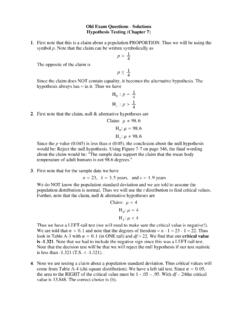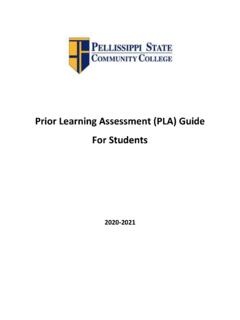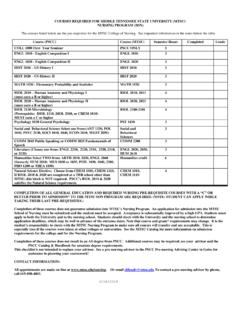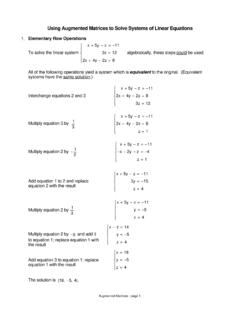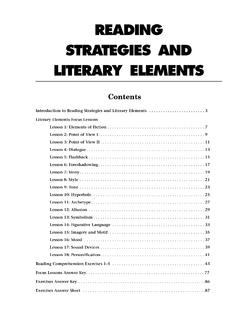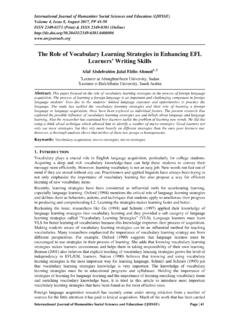Transcription of test taking strategies - Pellissippi State Community College
1 Test- taking strategies Preparing for tests taking tests Reducing Test Anxiety This is a packet of test- taking strategies designed to be used with Test- taking Workshops or with your instructor. The topics covered are: preparing for tests , taking tests , and reducing test anxiety. The types of tests covered are essay and objective. Objective examinations include multiple choice, matching, short answer, sentence completion, and true or false questions. Learning testing strategies will help to raise your test scores and your course grades. This information has been adapted from a variety of study-skills textbooks. The last page is a bibliography of these textbooks which are recommended by the Student Support Center.
2 PREPARING FOR tests . 1. Attend all classes. 2. Read all assigned material and take notes or write SQ3R questions. 3. Take organized and clear lecture notes. 4. Know your professors. 5. Make your presence known in class by your courtesy, cooperation and willingness to learn. 6. Ask questions to increase your understanding of course material. 7. Meet with your professors out of class. 8. Make use of tutoring services and Student Support Centers of the College . 9. Plan your study time. 10. Set study goals. 11. Learn the technical vocabulary of the course using index cards--use memory tricks such as associating difficult material with something you already know. 12. Organize the information you must remember 13.
3 Separate review time from daily assignments. 14. Start reviewing systematically and early, not just the night before the test. 15. Divide the review material into logical sections and concentrate on one at a time. 16. Practice predicting and answering test questions. 17. Learn test- taking terms and strategies . 18. Examine previous tests to ascertain what you did well and what you did not do so well. 19. Find out what kind of a test it will be: objective, essay, or a combination of both. 20. Find out when and where the test will be given; what you are expected to bring with you (pens); and what you are allowed to bring with you (dictionary). Get to the test site early with appropriate materials and do deep breathing exercises to relax.
4 Do not, at this time, continue to try to study. 21. Get plenty of sleep the night before the exam. 22. Get up early enough to avoid rushing and to eat a healthy breakfast. 23. Tell yourself you will do well - and you will! Test- taking strategies 1. GENERAL TEST- taking TECHNIQUES. 1. Before you start writing: GLANCE OVER THE WHOLE EXAM. This does two things for you: It gives you a set on the exam: what it covers, where the emphasis lies, what the main ideas seem to be. Many exams are composed of a series of short questions all related to one particular aspect of the subject, and then a longer question developing some ideas from another area. It may relax you because if you read carefully all the way through it, you are bound to find something you feel competent to answer.
5 OBSERVE THE POINT VALUE OF THE QUESTIONS and then figure out a rough time allowance. If the total point value for the test if 100, then a 50-point question is worth about half of your time regardless of how many questions there are. (Hint: A quick rule of thumb for a one-hour test is to divide the point values in half.). UNDERLINE ALL SIGNIFICANT WORDS IN THE DIRECTIONS. Many students have penalized themselves because they did not see the word or (example: Answer 1, 2, OR 3 ). You do not get extra credit for answering three questions if the directions said to answer ONE. In fact, you will probably lose points for not fully developing your answer. ASK the instructor if you do not clearly understand the directions.
6 2. When you begin to work: THERE IS NOTHING SACRED ABOUT THE ORDER IN. WHICH THE QUESTIONS ARE ASKED. Tackle the questions in the order that appeal to you most. Doing well on a question that you feel relatively sure of will be reassuring and will free your mind of tension. The act of writing often unlocks the temporarily blocked mental processes; when you finish that question , you will probably find the others less formidable. On the other hand, you may be the type of person who wants to get the hard one off his mind first and save the easy ones for dessert . Test- taking strategies 2. BE SURE TO IDENTIFY THE QUESTIONS CLEARLY so that the instructor knows which one you are answering. KEEP THE POINT VALUE AND TIME ALLOWANCE IN MIND.
7 This may save you from a very common and panic-producing mistake such as taking twenty minutes of an hour test to answer a five-point question , and then finding you have five minutes left in which to answer a twenty-point question ! Remember, it IS. POSSIBLE to score more than five points on a five-point question ! Work systematically, forcing yourself if necessary to do it. If you tend to rush at things, slow down. If you tend to dawdle, pace yourself. Write as neatly as possible while keeping to your time allotment. You are graded on accuracy, not neatness, but a neat paper may convince the instructor that the answer is organized and accurate. A. messy paper has the opposite effect! 3. When you are finishe d: CHECK OVER YOUR ENTIRE PAPER.
8 There are six reasons for this: 1) To see if you have left out any questions you meant to tackle later. 2) To see if you have followed directions. 3) To catch careless errors. Note: Don't take time to recopy answers unless you're sure they are really illegible. It's easier to be reasonably neat the first time. 4) Make sure you have numbered your answers correctly. 5) Make sure your name is on every page. 6) Make sure your answers are complete and that you have not left too much to the imagination of the professor. Test- taking strategies 3. TEST taking HINTS. HINTS FOR taking OBJECTIVE tests . 1. Use time wisely. 2. Read all directions and questions carefully. 3. Attempt every question , but do the easy ones first.
9 4. Actively reason through the questions. 5. Choose the answer which the test maker intended. 6. Anticipate the answer, then look for it. TRUE AND FALSE QUESTIONS. 1. Look for absolute qualifiers such as: always, all, nearly. If one is present, the question will probably be false. 2. Look for relative qualifiers such as: often, frequently, or seldom. These will probably be true. 3. If any part of the question is false, the whole question is false. 4. If you don't know the answer, guess; you have a 50-50 chance of being correct. MATCHING QUESTIONS. 1. Make sure you understand the directions for matching the items on the lists. For instance, can you use an item more than once? 2. Answer long matching lists in a systematic way, such as checking off those items already used.
10 3. Do the matches you know first. 4. Eliminate items on the answer list that are out of place or incongruous. 5. If you don't know the correct matches, guess. SHORT ANSWER QUESTIONS. 1. Write no more than necessary. 2. With sentence completion or fill-in questions, make sure your answers are grammatically correct. 3. Make sure your response makes sense. MULTIPLE CHOICE QUESTIONS. 1. Anticipate the answer, then look for it. 2. Consider all the alternatives. 3. Relate options against each other. 4. Balance options against each other. 5. Use logical reasoning. 6. Use information obtained from other questions and options. 7. If the correct answer is not immediately obvious, eliminate alternatives that are obviously absurd, silly or incorrect.
